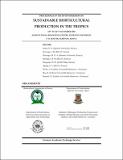| dc.description.abstract | The use of African indigenous vegetables (AIVs) among the many communities has gained
widespread popularity. These vegetables have a wide range of usage that include
provision of food, medicine, income and employment. Despite this, their potential in food
security and poverty alleviation has not been exploited. Production is constrained by lack
of good seed quality, poor farming systems and practices. Traditionally these crops have
been found in the wild or grown as intercrops with other indigenous vegetables or with
staples especially cereals and rarely occupy a significant portion of land. However there’s
hardly any study reported on intercropping African kale with other AIVs to ensure full
exploitation of the vegetables. Intercropping as a farming system increases agricultural
biodiversity controls weeds, pests, and diseases and increases productivity. The lack of
information however, has equally made it rather difficult to determine the most suitable
intercrop. The main objective of this study was to evaluate the suitability of intercropping
African kale with slenderleaf, cowpea, African nightshades, and spiderplant. The study
was conducted at Maseno University horticultural research farms during the long rains of
2005 (March- August 2005). Seeds were sown directly into the fields after ascertaining
viability. The experiment was laid out in a randomized complete block design (RCBD)
with five treatments replicated three times. The treatments were T1= African Kale, T2=
African kale/slenderleaf, T3= African kale/Cowpea, T4= African kale/Spiderplant, and
T5=African kale/African nightshades. Growth and biochemical measurements were taken
regularly and this included plant height, leaf number; stem diameter, branch number,
canopy spread, leaf area, leaf yield/edible portion, horizontal and vertical root lengths, and
chlorophyll determination. Intercropping African kale with the other four indigenous
vegetables had no significant effect on plant height, leaf number, branch number, stem
diameter, land equivalent ratio (LER) and vertical root length. However intercropping had
a significant effect on chlorophyll content, leaf area, leaf yield, canopy spread and
horizontal root length. African kale intercropped with cowpea, and African kale
intercropped with African nightshade showed a better performance compared to the other
intercrops. This could be due to less weed infestation, better moisture conservation and
stiff competition. | en_US |

